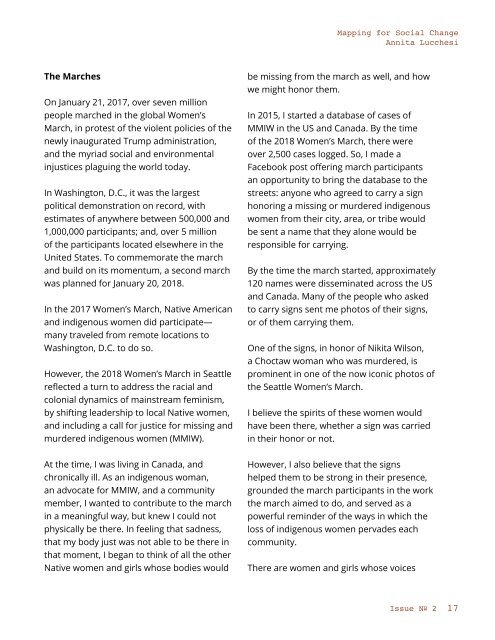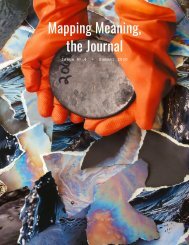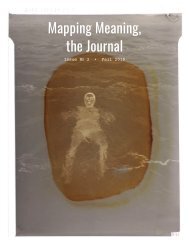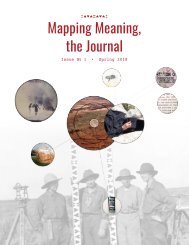Mapping Meaning, the Journal (Issue No. 2)
ISSUE SCOPE: Design Determines the Impact of Change
ISSUE SCOPE: Design Determines the Impact of Change
Create successful ePaper yourself
Turn your PDF publications into a flip-book with our unique Google optimized e-Paper software.
<strong>Mapping</strong> for Social Change<br />
Annita Lucchesi<br />
The Marches<br />
On January 21, 2017, over seven million<br />
people marched in <strong>the</strong> global Women’s<br />
March, in protest of <strong>the</strong> violent policies of <strong>the</strong><br />
newly inaugurated Trump administration,<br />
and <strong>the</strong> myriad social and environmental<br />
injustices plaguing <strong>the</strong> world today.<br />
In Washington, D.C., it was <strong>the</strong> largest<br />
political demonstration on record, with<br />
estimates of anywhere between 500,000 and<br />
1,000,000 participants; and, over 5 million<br />
of <strong>the</strong> participants located elsewhere in <strong>the</strong><br />
United States. To commemorate <strong>the</strong> march<br />
and build on its momentum, a second march<br />
was planned for January 20, 2018.<br />
In <strong>the</strong> 2017 Women’s March, Native American<br />
and indigenous women did participate—<br />
many traveled from remote locations to<br />
Washington, D.C. to do so.<br />
However, <strong>the</strong> 2018 Women’s March in Seattle<br />
reflected a turn to address <strong>the</strong> racial and<br />
colonial dynamics of mainstream feminism,<br />
by shifting leadership to local Native women,<br />
and including a call for justice for missing and<br />
murdered indigenous women (MMIW).<br />
be missing from <strong>the</strong> march as well, and how<br />
we might honor <strong>the</strong>m.<br />
In 2015, I started a database of cases of<br />
MMIW in <strong>the</strong> US and Canada. By <strong>the</strong> time<br />
of <strong>the</strong> 2018 Women’s March, <strong>the</strong>re were<br />
over 2,500 cases logged. So, I made a<br />
Facebook post offering march participants<br />
an opportunity to bring <strong>the</strong> database to <strong>the</strong><br />
streets: anyone who agreed to carry a sign<br />
honoring a missing or murdered indigenous<br />
women from <strong>the</strong>ir city, area, or tribe would<br />
be sent a name that <strong>the</strong>y alone would be<br />
responsible for carrying.<br />
By <strong>the</strong> time <strong>the</strong> march started, approximately<br />
120 names were disseminated across <strong>the</strong> US<br />
and Canada. Many of <strong>the</strong> people who asked<br />
to carry signs sent me photos of <strong>the</strong>ir signs,<br />
or of <strong>the</strong>m carrying <strong>the</strong>m.<br />
One of <strong>the</strong> signs, in honor of Nikita Wilson,<br />
a Choctaw woman who was murdered, is<br />
prominent in one of <strong>the</strong> now iconic photos of<br />
<strong>the</strong> Seattle Women’s March.<br />
I believe <strong>the</strong> spirits of <strong>the</strong>se women would<br />
have been <strong>the</strong>re, whe<strong>the</strong>r a sign was carried<br />
in <strong>the</strong>ir honor or not.<br />
At <strong>the</strong> time, I was living in Canada, and<br />
chronically ill. As an indigenous woman,<br />
an advocate for MMIW, and a community<br />
member, I wanted to contribute to <strong>the</strong> march<br />
in a meaningful way, but knew I could not<br />
physically be <strong>the</strong>re. In feeling that sadness,<br />
that my body just was not able to be <strong>the</strong>re in<br />
that moment, I began to think of all <strong>the</strong> o<strong>the</strong>r<br />
Native women and girls whose bodies would<br />
However, I also believe that <strong>the</strong> signs<br />
helped <strong>the</strong>m to be strong in <strong>the</strong>ir presence,<br />
grounded <strong>the</strong> march participants in <strong>the</strong> work<br />
<strong>the</strong> march aimed to do, and served as a<br />
powerful reminder of <strong>the</strong> ways in which <strong>the</strong><br />
loss of indigenous women pervades each<br />
community.<br />
There are women and girls whose voices<br />
<strong>Issue</strong> N o 2<br />
17







